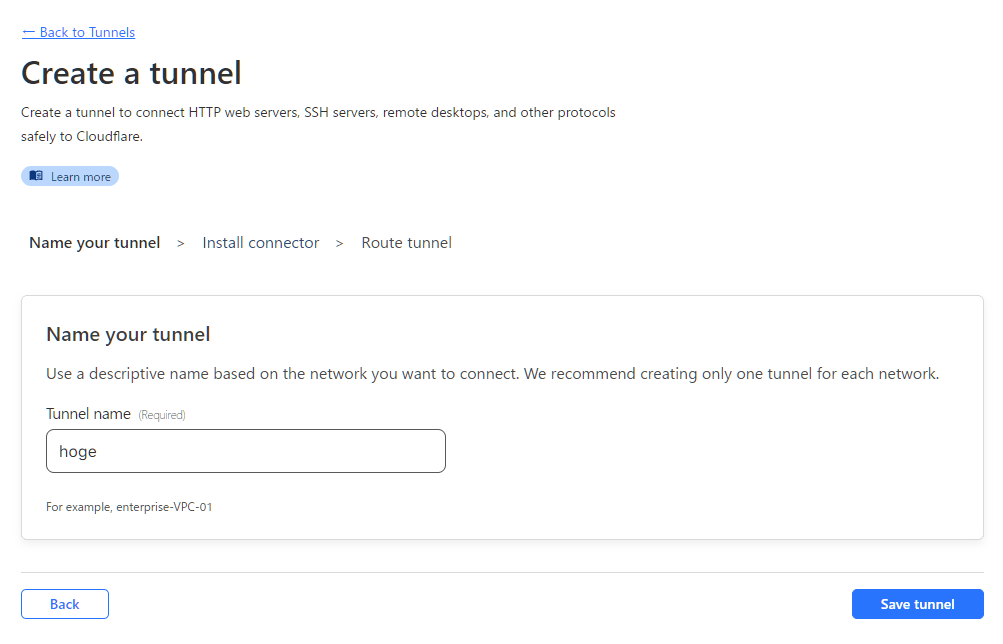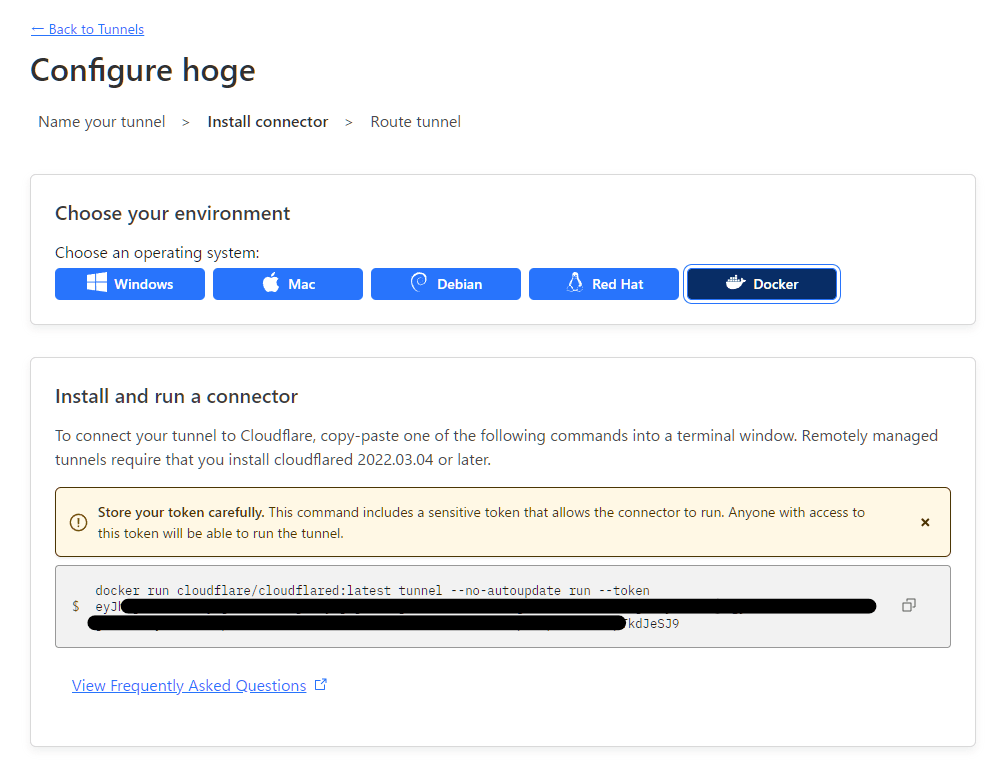Open1
MisskeyをDocker Compose+Cloudflare Tunnelでサクッと建てる
サクッとMisskeyインスタンスを建ててみたのでメモ。
前提として、Misskeyを公開するドメインは既にCloudflareで管理していること。
トンネルの作成
Zero Trust ダッシュボードを開き、Access > Tunnels に進む。
任意の名前でトンネルを作る。

トークンが生成されるので、これを控えておく。(コマンドは実行しない)

Public hostnameにはMisskeyインスタンスを公開するドメイン名を、Serviceにhttp://misskey:3000/を指定する。あとはSave tunnelで完了。DNS側の設定は自動で行われる。

Misskeyの起動
ディレクトリを作成。
$ mkdir misskey
$ cd misskey
$ mkdir -p data/db data/misskey data/redis
中身やこんな感じにする。
ディレクトリ構造
.
├── compose.yml
├── data
│ ├── db
│ ├── misskey
│ └── redis
└── default.yml
compose.yml
services:
misskey:
restart: always
image: misskey/misskey:13.13.2
depends_on:
db:
condition: service_healthy
redis:
condition: service_healthy
ports:
- "3000:3000"
volumes:
- ./data/misskey:/misskey/files
- ./default.yml:/misskey/.config/default.yml:ro
redis:
restart: always
image: redis:7-alpine
volumes:
- ./data/redis:/data
healthcheck:
test: "redis-cli ping"
interval: 5s
retries: 20
db:
restart: always
image: postgres:15-alpine
environment:
- POSTGRES_USER=misskey
- POSTGRES_PASSWORD=misskey
- POSTGRES_DB=misskey
volumes:
- ./data/db:/var/lib/postgresql/data
healthcheck:
test: "pg_isready -U $$POSTGRES_USER -d $$POSTGRES_DB"
interval: 5s
retries: 20
tunnel:
restart: always
image: cloudflare/cloudflared
command: tunnel run
environment:
- TUNNEL_TOKEN=トンネル作成の時に控えたトークン
#━━━━━━━━━━━━━━━━━━━━━━━━━━━━━━━━━━━━━━━━━━━━━━━━━━━━━━━━━━━━━━━
# Misskey configuration
#━━━━━━━━━━━━━━━━━━━━━━━━━━━━━━━━━━━━━━━━━━━━━━━━━━━━━━━━━━━━━━━
# ┌─────┐
#───┘ URL └─────────────────────────────────────────────────────
# Final accessible URL seen by a user.
url: https://トンネル作成の時にPublic hostnameで指定したドメイン名/
# ONCE YOU HAVE STARTED THE INSTANCE, DO NOT CHANGE THE
# URL SETTINGS AFTER THAT!
# ┌───────────────────────┐
#───┘ Port and TLS settings └───────────────────────────────────
#
# Misskey requires a reverse proxy to support HTTPS connections.
#
# +----- https://example.tld/ ------------+
# +------+ |+-------------+ +----------------+|
# | User | ---> || Proxy (443) | ---> | Misskey (3000) ||
# +------+ |+-------------+ +----------------+|
# +---------------------------------------+
#
# You need to set up a reverse proxy. (e.g. nginx)
# An encrypted connection with HTTPS is highly recommended
# because tokens may be transferred in GET requests.
# The port that your Misskey server should listen on.
port: 3000
# ┌──────────────────────────┐
#───┘ PostgreSQL configuration └────────────────────────────────
db:
host: db
port: 5432
# Database name
db: misskey
# Auth
user: misskey
pass: misskey
# Whether disable Caching queries
#disableCache: true
# Extra Connection options
#extra:
# ssl: true
dbReplications: false
# You can configure any number of replicas here
#dbSlaves:
# -
# host:
# port:
# db:
# user:
# pass:
# -
# host:
# port:
# db:
# user:
# pass:
# ┌─────────────────────┐
#───┘ Redis configuration └─────────────────────────────────────
redis:
host: redis
port: 6379
#family: 0 # 0=Both, 4=IPv4, 6=IPv6
#pass: example-pass
#prefix: example-prefix
#db: 1
#redisForPubsub:
# host: redis
# port: 6379
# #family: 0 # 0=Both, 4=IPv4, 6=IPv6
# #pass: example-pass
# #prefix: example-prefix
# #db: 1
#redisForJobQueue:
# host: redis
# port: 6379
# #family: 0 # 0=Both, 4=IPv4, 6=IPv6
# #pass: example-pass
# #prefix: example-prefix
# #db: 1
# ┌───────────────────────────┐
#───┘ MeiliSearch configuration └─────────────────────────────
#meilisearch:
# host: meilisearch
# port: 7700
# apiKey: ''
# ssl: true
# index: ''
# ┌───────────────┐
#───┘ ID generation └───────────────────────────────────────────
# You can select the ID generation method.
# You don't usually need to change this setting, but you can
# change it according to your preferences.
# Available methods:
# aid ... Short, Millisecond accuracy
# meid ... Similar to ObjectID, Millisecond accuracy
# ulid ... Millisecond accuracy
# objectid ... This is left for backward compatibility
# ONCE YOU HAVE STARTED THE INSTANCE, DO NOT CHANGE THE
# ID SETTINGS AFTER THAT!
id: 'aid'
# ┌─────────────────────┐
#───┘ Other configuration └─────────────────────────────────────
# Whether disable HSTS
#disableHsts: true
# Number of worker processes
#clusterLimit: 1
# Job concurrency per worker
# deliverJobConcurrency: 128
# inboxJobConcurrency: 16
# Job rate limiter
# deliverJobPerSec: 128
# inboxJobPerSec: 16
# Job attempts
# deliverJobMaxAttempts: 12
# inboxJobMaxAttempts: 8
# IP address family used for outgoing request (ipv4, ipv6 or dual)
#outgoingAddressFamily: ipv4
# Proxy for HTTP/HTTPS
#proxy: http://127.0.0.1:3128
proxyBypassHosts:
- api.deepl.com
- api-free.deepl.com
- www.recaptcha.net
- hcaptcha.com
- challenges.cloudflare.com
# Proxy for SMTP/SMTPS
#proxySmtp: http://127.0.0.1:3128 # use HTTP/1.1 CONNECT
#proxySmtp: socks4://127.0.0.1:1080 # use SOCKS4
#proxySmtp: socks5://127.0.0.1:1080 # use SOCKS5
# Media Proxy
#mediaProxy: https://example.com/proxy
# Proxy remote files (default: false)
#proxyRemoteFiles: true
# Sign to ActivityPub GET request (default: true)
signToActivityPubGet: true
#allowedPrivateNetworks: [
# '127.0.0.1/32'
#]
# Upload or download file size limits (bytes)
#maxFileSize: 262144000
あとは起動するだけ。
$ chmod 777 data/misskey
$ sudo docker compose up -d
参考